That’s just a little deceptive
| November 22, 2014 | Posted by Melinda under Uncategorized |
Here’s the deal. You don’t get to call your product “Safe Choice”, and advertise on the label that it is “controlled carb”……
…And then have cane molasses be one of the top ten ingredients.
I was so confused by this apparent dichotomy that I actually spent time on the site, trying to figure out what the logic was.
Apparently the logic is that since this feed should make up just a small portion of the horse’s diet, that the actual amount of molasses (and NSC’s in the feed) contributed to the diet is relatively small, and therefore this counts as “controlled”.
After all, (as the site points out), that forage hay which the horse is eating much more of contains much MORE absolute amount of sugar than the molasses in this product.
Here’s the problem.
It’s not just about the absolute amount of non-structural carbohydrates (NSC), even in non-insulin resistant type horses.
It’s also about particle size and lactic acid producing bacteria and their association with ulcers, and a MYRIAD of other things.
The PARTICLE size associated with the carbs in the FORAGE part of the diet is COMPLETELY different than the particle size associated with your relatively controlled moderate carb pelleted feed.
As a consumer intending to reach for an ACTUAL controlled carb supplemental feed, I feel a bit insulted by their “logic” and more than a little manipulated.
It’s FINE that your product includes molasses and even that startchy-small-particle-corn up there on the label.
It’s NOT fine that you tote this as a controlled starch feed since “you only feed a small amount”.
PS – wanna try your hand at some vet board questions? Here’s 60 sample questions provided by the testing agency. No cheating! I got 19 wrong (~68% score), what was your score?. Typically scores in the 55-65% range pass.
EDIT
I truly thought I was the only one that was surprised by the SafeChoice label, so I didn’t want to go into too much boring depth, but since it seems some of my readers feed this product and are also surprised, I’m adding some screen shots from the feed’s website info that I didn’t end up using in the above post. (click to enlarge)
Above is the actually guaranteed analysis. Dietary Starch is max 17% and Sugar is max 5%. There’s a note on both of these that NSC (Non-structural Carbohydrates) = Dietary Starch + Sugar.
This makes Safe Choice original NSC = 22
With some digging, I found this statement on their site:
Apparently, while “original” is a “controlled carbohydrate” feed, the company doesn’t even consider it a truly low starch feed. That distinction goes to the “special care” version.
Here’s a screen shot that comes for a page where I found out that apparently the company intends “controlled carb” to actually mean that it’s a concentrated enough feed that you feed less of it, so the horse gets less molasses than feeding an equivalent nutritional profile of one of their competitors. Here they help us do simple math to help us understand why a NSC of 22 really isn’t that scary:
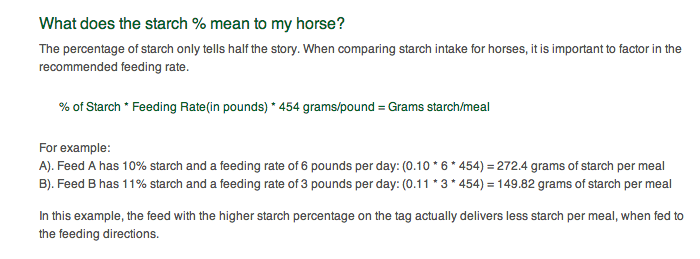 I saved you from their calculation of how many carbs are in a flake of hay, since it mentions nothing about effective fiber length (and thus that discussion deserves more than just a set of calculations talking about grams of sugar in alfalfa), and IMO I don’t want to hear the feed bag company blame my hay for the source of NSC in my horses diet – I want to hear how the feedbag company is addressing my need to not add any additional NSC into the diet that I can avoid – like in the supplements.
I saved you from their calculation of how many carbs are in a flake of hay, since it mentions nothing about effective fiber length (and thus that discussion deserves more than just a set of calculations talking about grams of sugar in alfalfa), and IMO I don’t want to hear the feed bag company blame my hay for the source of NSC in my horses diet – I want to hear how the feedbag company is addressing my need to not add any additional NSC into the diet that I can avoid – like in the supplements.
Bottom line: I’m not saying *you* have to take corn and molasses out of your horse’s diet just because I’ve chosen to. Or even that this 22% feed is putting your horse at risk if being feed in small amounts. *HOWEVER*, I do think that they way this product is labeled is misleading and confusing, and that is what pisses me off.


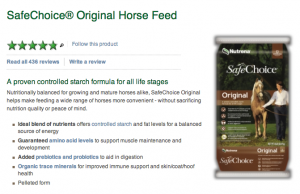
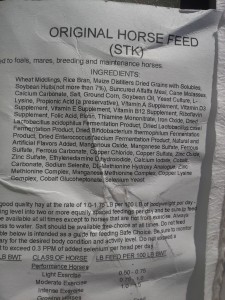
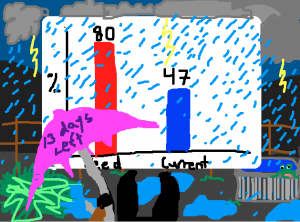

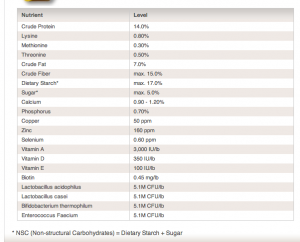










I sadly knew that about “safechoice”. Major thinks it is crack, so I’ll use a little bit to top off the plain grass hay pellets and beet pulp. I found it easier to just essentially make a feed up myself, with a mineral balancer, salt, yeast, etc. Works with one horse. But with a growing baby, older horse, you have a different situation.
Oh, and I took the practice test. Obviously too much time on my hands. I know nothing about vet stuff, it it showed. 14/60, 23%, woohoo. That career is safe from me, I’ll stick with being a designer.
LOL about the test. Like endurancedownunder thanks for being a good sport :). On the feed stuff – that’s where I am with Farley. When I get out of school (craziest 2 weeks of my life right now) I’m really hoping to be able to put together something for ML, but in the meantime. Ugh. Its 10am and I’m still in my PJ’s trying to study for boards on my 3rd cup of coffee in my first day off in 14 days and I’m feeling stressed because I still haven’t gone to the stable to medicate ML this morning (and had ot have my husband do it last night because one of my patients popped with salmonella – a type that kills horses – so I couldn’t go out last night…) so I keep telling myself that NOW is not the time to make ML’s feed more complicated! LOL.
Obviously my LOL’s in above comment are borderline hysterical. Going to the stable to medicate a pony now.
I got 73%…Vet for 20 years, 7 years in exclusively agricultural (sheep and cattle mostly) practice. So I was pretty happy with that!
thanks for being such a good sport :). 8 more days to go! I’m not really stressed about the test….just stressed on a day to day basis getting in the studying that I need to be where I want to be on the day I take the test. But no matter whether I hit that goal or not (80% on vet prep so I have a fail-guarantee) I don’t think it will change the stress the feel on the actual day of the test (I’m not usually someone that stresses over the actual test).
Hi again- I was re reading this and wondering if maybe you can further explain something. what are you referring to with “particle size” and how it related to lactic acid in this comment?? would you mind expanding your explanation a bit?
” It’s not just about the absolute amount of non-structural carbohydrates (NSC), even in non-insulin resistant type horses.
It’s also about particle size and lactic acid producing bacteria and their association with ulcers, and a MYRIAD of other things.
The PARTICLE size associated with the carbs in the FORAGE part of the diet is COMPLETELY different than the particle size associated with your relatively controlled moderate carb pelleted feed.”
Thank Mel!
Here’s the post where I explain the concept (it’s the second “section” of the post – make sure to look at the comments where i got a clarification from the nutritionist that it isn’t just the “suspension of the particles” that makes smaller stuff like beet pulp not an issue, it’s also because it’s a low startch feed so the smaller size is OK
Would help if I actually gave you the link: https://melnewton.com/2013/the-last-of-my-nutrition-tidbits/
Thanks Mel! I will read up. I realized after I asked you about ML being more at risk for ulcers that your poor little filly has had a rough go and that was LIKELY the reason you were playing it safe in respect to managing her diet as if she may be prone to ulcers.. Sometimes my fingers engage before my brain on the magic box!
In doing some further investigation, I ran across this Thesis paper regarding the ulceration variations in horses when comparing horses on a textured feed (concentrate) versus pelleted feed
http://repository.tamu.edu/bitstream/handle/1969.1/ETD-TAMU-2011-12-10594/HUTH-THESIS.pdf?sequence=2
Thought it was interesting.
Yep, list me among the annoyed people who thought Safechoice was a safe choice…
I guess I’ll go back to buying Elk Grove by the bag, I just didn’t have luck with the barrels staying sealed and some quality concern but I haven’t heard issues with the bag…
Lame Nutrena, lame.
Interesting post…I’ve been looking around to find a new feed for Nimo because I’ve been seeing some quality control problems in the Pennfield Fibregized that I’ve been feeding him ever since Cargill bought the company. I have to admit that I’m kind of at the point where I don’t think any bagged feed is that great and I’m sort of looking for the least worst. Right now I’m trying out a feed, called Pace-Maker Fiber Focus, formulated by Kentucky Equine Research and sold by a local chain of farm supply stores. It’s significantly cheaper than other options from Purina and Nutrena and I’m not sure if that’s a good or a bad thing. Here’s the link in case anyone is interested: http://www.cfcfarmhome.net/Feeds/Equine/PaceMakerFeeds/paceMakerFiberFocus.aspx.
A big problem with boarding horses in my area (as well as other states I’ve lived in) is that horses just don’t get enough hay. They sometimes go hours without any probably due to laziness of the barn staff, financial concerns of the barn owner, ignorance of the barn manager, and the thinking that if a horse is too fat, you need to cut his hay (instead of maybe trying out a slow feeder). Because Nimo is working so much, I want him to eat as much hay and grass as he can stuff in his face and my preference would be to feed very little concentrate, but even feeding free choice hay, I’ve found he needs three meals a day of probably 2-4 pounds of concentrate, depending on how much we’re conditioning.
In terms of starch, I’ve just started learning more about it, but aren’t there different kinds of starch? With some being better than others? For example, I know I’ve read oats are considered a better starch than corn or barley because it seems like horses digest oats better and there is less of an insulin spike. I’m kind of wondering about feeding straight oats (along with some alfalfa to balance the calcium/phosphorus ratio)…Any thoughts?
Carbs are problematic for several reasons – insulin spikes, regional acidosis, and increasing the chance you will hit a “wall” during aerobic endurance type activities. NSC is specially my concern and oats are high in NSC so I would not choose to feed it (or corn) because of that. If a horse needs more calories than can be provided with forage based stuff, I tend towards the oils. But that is personal perference.
LMF makes some really good low NSC feeds, and even a Senior Low Starch… AND they list all their
ingredients on their website. Trying to find the list of ingredients in Nutrena “Safe” Choice was a
challenge… and yes, cane molasses, which is also in LMF Gold. I would expect a feed store that
carries the Gold should be able to order one of the others for you. Price here in NoCal for 50# of the
Senior Low Starch just under $18, so comparable. I believe it’s considered a complete feed – seems to
be horse-approved as far as palatability.
One other plus- the rep i’ve talked to – who puts up a stand and suffers the heat of the Foresthill vet
check at Tevis- knows her stuff, and speaks “endurance”.
PS- my understanding is the original Safe Choice Original is now Safe Choice Special Care – and the
current “Original”… well, isn’t…
(and *I* haven’t had a couple of beers… but maybe i should….)
um… timing is everything…. In light of your edit, i’m pretty sure my comment above is totally unnecessary. sigh…
Just added some additional screenshots etc that I didn’t originally include because honestly I didn’t think anyone would actually be interested in this subject
Well crap…. (Interesting you posted on this actually)
This is the feed I switched Otto to after he decided one morning, out of the blue , that he no longer liked his Mare and Foal. AND I noticed the molasses and corn. but went with it anyways…for the time being..
When Otto just up and refused to eat his Mare and Foal one morning, I was faced with dealing with an unexpected feed change,and not to mention , a rapid feed change. For obvious reasons, I had to keep him on something because he needed to keep gaining weight so my main concern was choosing something where the feed and ingredients would be as close as possible as what he had been getting with the mare and foal. As it turned out, the Safechoice Original Formula was just that..
He has been on it the Original formula about 3 weeks now and ofcourse loves it ( thank you molasses) but he is not getting what I consider a “small amount” . I have been giving him 4 lbs a day , well below the recommended amount according to the feed tag) with beet pulp and Equipride. Otto has been under weight so our goal was to “catch him up”. If the company states that the intent of the feed is to only feed a small amount, that concerns me considering how much he is actually getting. What do they consider a small amount? 1 lb? 2 lbs? a handful??? According to the feed tag for a growing horse, they suggest .75-1.5 lbs per 100 lbs of horse weight. Otto is 750 lbs. If I followed that, I would be feeding a whopping 7 lbs of grain a day. That is DEFINITELY not a small amount!! So where does the part about intention to only be fed in small amounts come in?? talk about confusing..
I just had Otto at the vet today for his boosters and to check the spot on his pastern (which is fine by the way and not a sarcoid) . We weighed him and he has gained 100 lbs in 2 months. Body condition wise he is finally where he needs to be. So now, I am wondering , given what you have discovered about this product, if it makes more sense to back him off or switch feeds completely.
Otto , like ML is a growing horse with different energy requirements but I definitely want him on a TRUE NSC
Your absolutely right, their formula is deceiving and I did not realize that it’s “intent” was to only feed a small amount. This is game changer in my opinion.
ML being a two year old is technically not on the growing rate any more and I’ve capped her at 3 pounds (which is the label recommendation), which is a relatively small amount – BUT I’ve noticed she’s stopped gaining weight. Elk Grove Milling stable mix is only sold by one local feed store and I can’t often get there…so bought safechoice at a chain store hoping to get something close to stable mix which is corn and mollasses and oat etc free. Obviously it’s not. But to my dismay, it’s not even an OK substitute. She was really looking good on stable mix….and has basically remained static on the safechoice, not gaining or losing. Managed to snag a couple of bags of stable mix last weekend so now I’m mixing the two until I’m out of safechoice and then go back to stable mix exclusively.
My plan if I run out of stable mix again is to do a mix of beet pulp + calf manna + stablized rice bran + forage pellet or cube (like alfalfa or timothy pellets or something). I can pick up all those individually at the chain store if needed and make due until I can get more stable mix.
Aarene – for a horse who isn’t at risk for ulcers or doesn’t have a history of a carb related “thing” (such as a tie up) I probably wouldn’t worry about the amount of molasses that is in safe choice in the 2-3 pound range. HOWEVER, small carbohydrate rich particles are a risk factor for ulcers. So if a horse is prone, it’s asking for trouble. In horses, effective fiber length is about the size of an alfalfa cube, meaning that carbohydrates that are in the form of forge that has an effective fiber length of an alfalfa cube or greater doesn’t carry the same risk for ulcers. Beet pulp is shorter than the effective fiber length but isn’t carbohydrate dense, so doesn’t have the same problem. But molasses and fine corn particles……ugh. For MerryLegs I don’t mind the molassas and carbs…but I’m REALLY worried about ulcers. For Farley, I’m less worried about ulcers, but with her history of a tie up I’m REALLY conservative when it comes to any NSC in her diet. Making Safe choice not a good choice for either of them.
I’ve had a couple beers so perhaps this doesn’t make sense at all…but I figured it was worth a shot :).
Fascinating.
Are there other “chain store” mixes that would be better? LMF Gold is common here, and Purina products, of course.
Fee did have one mild tie-up two years ago, pre-spay and almost certainly rider error (not nearly enough elytes). The only symptom she showed that day was pink-lemonade urine. No stiffness no reluctance to move, etc. But I will remain overly cautious now and forever!
Thanks for not just telling “what” but also explaining “why.”
I really liked LMF gold when I used it. Ended up switching to EGM stable mix mostly because I was having to special order LMF and it was inconvienent. LMF carries some low NSC lines that are super low that I would be tempted by if I could get LMF local. I’m really lucky that I live where EGM is available, otherwise I think I would probably go back to LMF.
Nikki points out below that lmf gold has molassess. I fed it prior to farleys tie up before I was a label nazi. Its not an option for ml since Iit’s too far towards performance for what im doing but ymmv. Lmf has lots of low nsc feeds I like too.
Question for you, Mel. I can’t get Stable Mix out here in FL, so I’ve been feeding my girl basically what you will feed if you run out of SM but without the Calf Manna (no-molasses beet pulp, stabilized rice bran, hay cubes). Can I ask why you would add the Calf Manna? Trying to learn, thank you for your help!
I add calf manna for two reasons. I dont feed a lot of alfalfa here because of the enterolith issue (seems to be a ca alfalfa issue) and so for a working or growing horse I like the amino acid profile of calf manna. For really bigevents (endurance rides etc) ill throw a flake of alfalfa but adding something to the mash for lighter days. I also like calf manna for the flavor. They use anise etc so I can flavor a mash without extra molasses for most cases.
We dont have anything like stable mix available locally…could you tell me what the company name is? I have no idea if Otto is at risk of ulcers but I think it would be low??? .He is on full turn out , lots of hay, pretty easy low stress lifestyle. How have you determined ulcer risk with ML? ( just curious).
The company that makes stable mix is “Elk Grove Milling”.
MerryLegs hasn’t eaten as well as she should since coming here in her first couple of months, and she’s always been on the thin side and not been putting on weight, despite 24/7 hay and supplemental feed. this of course only worsened when she got sick. Because she was on HEAVY doses of NSAIDS, and anorexic I put her on gastrogard (ulcergard or gastrogard – which ever is the higher ocncentration one)about 48 hours after she really crashed, when we were pretty sure she was going to survive at least the first week or so.
It could have been a complete coincidence, but about the time the gastrogard would have been taking effect, all of a sudden she started eating a LOT better than she had EVER before and starting gaining weight. I kept her on it afor about 10 days, until we stopped giving her IV banamine and she was off NSAIDs for a couple of days. Her response to ulcer gard makes me think that she either had ulers as a result of her illness/treatment, OR that she had low level ulcers this entire time. So, at least until she is off of antibiotics and I see her weight improve more, and she continues to have a good appetite consistently, I consider her at high risk for ulcers. Every month since I’ve gotten her it seems like *something* has changed (the specific pen she’s in, or her pasturemate, or getting sick, etc.) and so I REALLY want to see some consistency in her life and health and appetite before I say that I feel like she’s at risk long term and I take additional measures like getting her scoped (although that won’t tell me whether she has hindgut ulcers). My working theory right now is that she really just had a perfect storm of factors the last 6 months or so (sorta like Farley – I don’t think she’s a horse that is especially prone to tying up…but a perfect storm of factors led to a tye up so I can never totally discount it).
Just like it could be my imagination/coincidence that she showed improvement on gastrogard, I *also* feel like her appetite for hay hasn’t been quite as good since I started using safechoice. And she’s stopped gaining weight.
Calf Manna also isn’t available here.. I have tried to find it in the past.. no luck..
I think I want to know more.
Fee does NOT have insulin resistance issues. She eats mostly pasture (4 acres of now-dead mixed swampgrass and weeds…not excellent quality, but there’s a TON of it and it’s just her and two fat goats out there) and gets about a pound of SafeChoice (divided into two feedings) daily, on top of 8 cups of beetpulp (measured dry, I feed it wet, and again this is divided into 2 servings daily).
She gets a flake of hay at night in her stall, maybe 2 or 3 flakes if it’s really cold. In winter I feed a flake or two of hay mid-day when it’s cold.
Before she was spayed, she was a very hard keeper. I fed a bunch more hay and kept a heavy blanket on her to keep her from shivering. If anybody ever wonders if pain eats energy, the answer is YES.
Two years post-spay, I find myself cutting feed back more and more–she’s pretty plush right now, and we are only working 2 days per week for a couple hours each day.
I like feeding beetpulp especially during cold weather because of the moisture content–she’s not an awesome water drinker in cold weather, even with a tank heater, but she will eat ALL the beetpulp. I put salt in the beetpulp too, per Susan G.
So, very minimal servings of Safechoice, mostly to disguise the Equerry vitamin pellets.
Suggestions?
wrote a little note to you below in the reply to Jonna. :). Sort got on a roll and just blabbed out all my thoughts in one place.